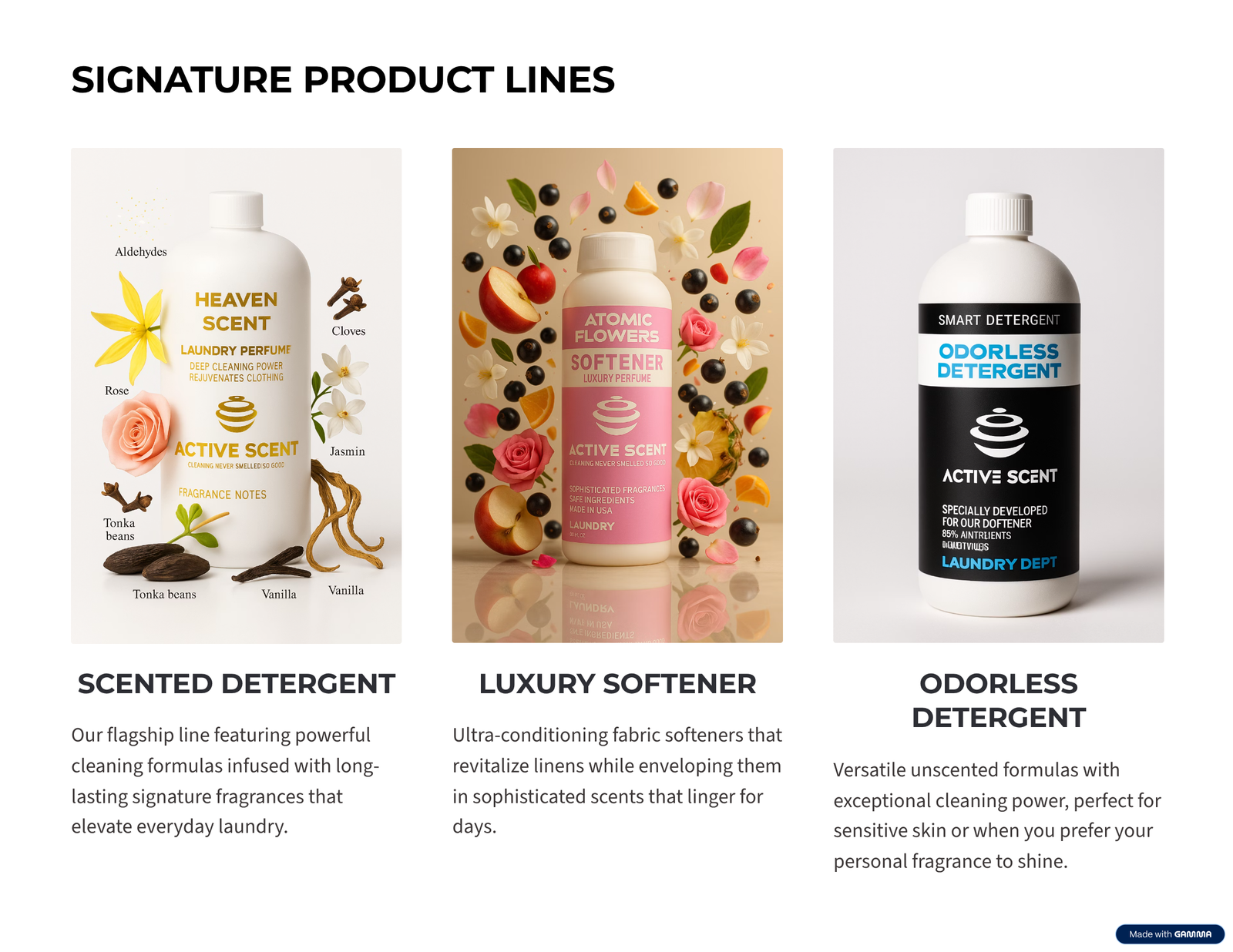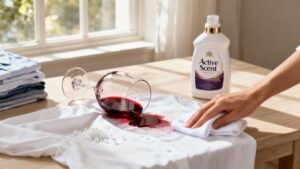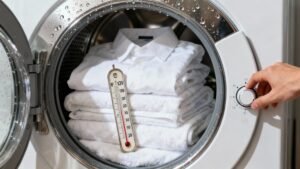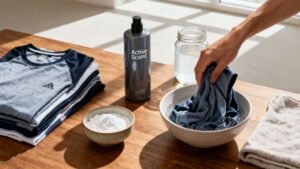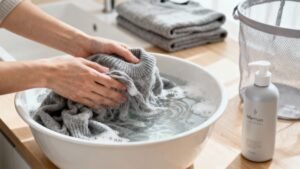
A Guide to Eco Friendly Laundry Detergent
When you hear the term eco-friendly laundry detergent, what comes to mind? It’s not just about a “green” label. It’s about a complete reimagining of what it means to get your clothes clean—a smarter approach that’s both powerful on stains and gentle on the planet.
This is a cleaning product designed from the ground up to minimize its environmental footprint, from the ingredients in the bottle to the bottle itself.
What Makes a Laundry Detergent Eco-Friendly?

Choosing an eco-friendly laundry detergent isn’t about picking one special ingredient. It’s about embracing a whole philosophy of sustainability. Think of it as a shift away from the “fast fashion” model of conventional detergents, which often blast stains with harsh, petroleum-based chemicals for a quick fix.
Instead, this is a more thoughtful, “timeless classic” approach. It’s built on a few core principles that create a powerful clean without costing the health of our planet or our families.
The Pillars of an Eco-Friendly Formula
It all starts with the ingredient list. True eco-friendly detergents are built with plant-derived surfactants—the cleaning agents—that come from renewable sources like coconut or corn. They also bring in natural enzymes to methodically break down stubborn stains, giving you a deep clean without the chemical aggression.
Just as important is what isn’t in the bottle. These formulas are consciously created to avoid ingredients known for their harmful impact, such as:
- Phosphates: These minerals create havoc in our waterways, leading to algal blooms that suffocate aquatic life by depleting oxygen.
- Optical Brighteners: These don’t actually make your clothes cleaner. They’re essentially chemical coatings that trick the eye into seeing a brighter white, but they don’t biodegrade and can be a real problem for sensitive skin.
- Chlorine Bleach: A famously harsh chemical that can weaken fabrics over time and release toxic compounds into the environment.
More Than Just a Clean
The philosophy extends beyond the formula to packaging and production. Brands truly committed to sustainability use recycled, recyclable, or even compostable packaging to cut down on plastic waste. Many also offer concentrated formulas, like powders or strips, which dramatically reduce shipping weight and carbon emissions.
And let’s bust an old myth: “green” absolutely does not mean less effective.
Today’s eco-friendly detergents deliver a superior clean that protects your fabrics and keeps colors vibrant. They provide a powerful, odor-free base that is incredibly gentle on sensitive skin, making them the perfect choice for the whole family. If you’re curious about the specifics, you can learn more about the benefits of laundry detergent without chemicals and how to spot the right ingredients for your needs.
When you make the switch, you’re not just getting clean clothes. You’re protecting aquatic ecosystems from harmful runoff and keeping potential irritants out of your home. It’s proof that a truly exceptional clean can—and should—be environmentally conscious.
Conventional vs. Eco-Friendly Detergent at a Glance
To make it even clearer, let’s break down the key differences between the old way and the new way of thinking about laundry. This table gives you a quick snapshot of what sets them apart.
| Feature | Conventional Detergent | Eco-Friendly Detergent |
|---|---|---|
| Cleaning Agents | Petroleum-based surfactants | Plant-derived surfactants (e.g., coconut, corn) |
| Stain Removers | Harsh chemicals, chlorine bleach | Natural enzymes, plant-based ingredients |
| Brightening | Optical brighteners (chemical coatings) | Natural ingredients that clean, no coatings |
| Biodegradability | Low; contains persistent pollutants | High; designed to break down safely |
| Packaging | Virgin plastic containers | Recycled, recyclable, or compostable materials |
| Skin Impact | Can contain common irritants and allergens | Hypoallergenic, gentle on sensitive skin |
As you can see, the choice goes far beyond just getting out a stain. It’s about how your detergent impacts everything from your skin to the world’s waterways.
The Hidden Cost of “Clean”

To really get why an eco-friendly detergent matters, we have to pull back the curtain on the conventional brands most of us grew up with. That bright, “fresh linen” scent and the promise of dazzling whites? It’s a great story, but it often hides a darker one—a story of significant harm to our health and the planet.
This isn’t a single misstep. It’s a chain reaction that starts with how these detergents are made and continues long after your laundry is folded and put away.
Most of the big-name detergents get their cleaning power from petroleum-based surfactants. These are made from crude oil, a non-renewable resource whose extraction and refinement pump carbon into our atmosphere. Once they’ve done their job in your washing machine and swirl down the drain, their impact is just getting started.
The hard truth is that our water treatment facilities just aren’t built to catch all the complex, synthetic chemicals packed into traditional detergents. So, where do they go? Straight into our rivers, lakes, and oceans.
Choking Our Waterways, One Load at a Time
One of the worst offenders, historically, has been phosphates. While many places have cut back on them, they haven’t disappeared completely. In the water, phosphates act like a super-fertilizer for algae.
This triggers massive, out-of-control algal blooms, a process called eutrophication. Think of it as a thick green blanket that smothers the water’s surface, blocking sunlight from reaching the plants below. When all that algae eventually dies and decomposes, it sucks up enormous amounts of oxygen from the water.
The result is what scientists call “dead zones.” The oxygen levels drop so low that fish and other aquatic life literally can’t breathe. Entire ecosystems suffocate from the inside out.
And it’s not just phosphates. Other additives, like synthetic fragrances and “optical brighteners” (the chemicals that trick your eyes into seeing whiter whites), are often toxic to marine life. They don’t break down easily, meaning they build up in the environment and work their way up the food chain, poisoning the delicate web of aquatic life.
The Problem in Your Home: Plastic Waste and Irritated Skin
The damage isn’t just happening “out there” in the environment. It starts with the bottle itself. Think about those huge, single-use plastic jugs. Billions of them are thrown out every year, clogging landfills where they can sit for hundreds of years before breaking down.
And the very ingredients that wreak havoc on ecosystems can cause problems for your family, too. Those same artificial fragrances, dyes, and harsh cleaning agents are notorious for causing skin irritation, triggering allergies, and even contributing to respiratory issues, especially for people with sensitive skin.
Switching to an eco friendly laundry detergent isn’t just about making a “green” choice. It’s about consciously stepping out of this destructive cycle. It’s about choosing a powerful clean that doesn’t come at the cost of our planet’s health or your family’s well-being.
How to Read a Detergent Ingredients Label

Stepping into the laundry aisle can feel like an ambush. Bottles scream vague promises like “natural” or “green,” but the real story is always hidden in the fine print. Learning to read an ingredients label is the single most important skill for choosing a detergent that’s genuinely good for you and the planet.
Think of it like shopping for food. You don’t just grab the box with the prettiest art; you check for real ingredients and skip the artificial junk. It’s the same logic here. That confusing list of chemicals can become a clear roadmap to a smarter, more sustainable choice.
What to Look For on the Label
A truly eco-conscious formula is built from ingredients that are powerful on dirt but gentle on the earth. When you’re scanning a label, keep your eyes peeled for these champions of clean. They work with nature, not against it.
- Plant-Based Surfactants: These are the workhorses of any detergent. Look for names like coco-glucoside (from coconut) or lauryl glucoside (from corn). They create the suds that lift away grime, but unlike their petroleum-based cousins, they come from renewable sources and biodegrade easily.
- Stain-Fighting Enzymes: Ingredients like protease, amylase, and lipase are nature’s own stain removers. Each one is a specialist: protease tackles proteins (like grass stains), amylase handles starches, and lipase breaks down fats and oils—all without a single harsh chemical.
- Natural Minerals: Sometimes, the simplest ingredients are the best. Earth-derived minerals like sodium carbonate (washing soda) and sodium bicarbonate (baking soda) act as natural water softeners and cleaning boosters, helping the whole formula work better.
Ingredients to Avoid
Knowing what to look for is only half the battle. Knowing what to leave on the shelf is just as crucial. These common additives are red flags for anyone trying to make a cleaner choice, often posing risks to our waterways and our families.
A truly exceptional clean shouldn’t come at the cost of your well-being or the planet’s. Active Scent’s odor-free laundry detergent has been carefully formulated for a deep and effective clean, without competing fragrances. It’s the ultimate neutral base, created to perfectly complement our range of luxury scented fabric softeners.
Here are the key culprits to avoid:
- Phosphates: Notorious for polluting water and causing harmful algal blooms that choke aquatic life.
- Chlorine Bleach: A harsh chemical that can weaken fabrics over time and release toxic compounds into the air and water.
- Phthalates: Often hiding under the vague term “fragrance” or “parfum,” these chemicals are linked to a host of health concerns and they don’t break down in the environment.
- Synthetic Dyes: Added for looks, not for cleaning. They offer zero benefit and can be a source of skin irritation for many people.
Decoding Certifications and Logos
To cut through the marketing noise and “greenwashing,” let a trusted third-party do the vetting for you. These official logos are a reliable shortcut, signaling that a product has met strict standards for both safety and environmental impact.
Two of the most respected certifications in the U.S. are:
- EPA Safer Choice: This label means the U.S. Environmental Protection Agency has audited every single ingredient. It confirms the product is safer for people and the planet without compromising on performance.
- USDA Certified Biobased Product: This seal verifies that a significant portion of the product is made from renewable, natural sources like plants, forests, or marine materials.
By focusing on these key ingredients and looking for trusted certifications, you can move past the marketing hype. You’ll be able to confidently choose an eco friendly laundry detergent that truly aligns with your values—for a cleaner home and a healthier world.
Choosing the Right Eco Friendly Detergent Format

The world of eco-friendly laundry has evolved. Gone are the days of a single, one-size-fits-all product. Today, you have real choices—options that let you tailor your laundry routine to your lifestyle, your values, and your desire for a truly clean, sustainable wash.
Deciding between liquids, powders, pods, or strips isn’t just about what’s easiest to grab off the shelf. It’s a conscious choice, a balance between convenience, cost, and environmental impact. Let’s break down what each format really offers so you can find the perfect match for your home.
Liquids and Powders: The Classics, Reimagined
Eco-friendly liquid detergents feel familiar. They’re versatile, work well in any water temperature, and are fantastic for pre-treating stubborn stains right on the fabric. The trade-off? They’re heavy, which means a bigger carbon footprint from shipping, and they almost always come in plastic jugs.
Powders, however, are making a serious comeback, and for good reason. They’re typically sold in simple cardboard boxes—a huge win for anyone trying to ditch plastic. Because they’re just concentrated cleaning agents without the water, they’re lighter to ship and often give you the lowest cost per load. Powders dissolve best in warm or hot water, making them a powerhouse for heavily soiled laundry.
Pods and Strips: The Modern Innovators
Laundry pods are all about pre-measured convenience. No spills, no guesswork. Just toss one in and go. But there’s a catch: the PVA (polyvinyl alcohol) film that holds the detergent is a hot topic. Its ability to fully biodegrade in all wastewater systems is still up for debate.
Then you have laundry strips, the ultimate minimalist option. These are feather-light, dehydrated sheets of detergent that dissolve instantly in hot or cold water. They arrive in a simple, compostable cardboard sleeve, leading to zero plastic waste and a dramatically smaller carbon footprint. Their tiny size makes them a game-changer for small apartments, travel, or anyone who just wants less clutter.
No matter which format you choose, a high-quality, unscented eco-friendly laundry detergent provides the perfect neutral base. This powerful cleaning action prepares your fabrics to be paired with luxurious, scented fabric softeners, allowing you to customize your fragrance experience without compromise. At Active Scent, our powerful detergents are fused with luxurious fragrances, delivering a spark of joy and a surge of confidence in one exceptional product.
Choosing the right format can feel overwhelming, so let’s make it simple. We’ve broken down the key differences to help you decide which one best fits your priorities, from packaging to performance.
Eco Friendly Detergent Format Comparison
| Detergent Type | Pros | Cons | Best For |
|---|---|---|---|
| Liquids | – Excellent for pre-treating stains. – Works in all water temperatures. |
– Heavy, increasing shipping emissions. – Packaged in plastic. |
Those who frequently need to spot-treat stains before washing. |
| Powders | – Often the most budget-friendly. – Plastic-free packaging (usually). |
– Can be messy to measure. – May not fully dissolve in very cold water. |
Budget-conscious households looking for a powerful, plastic-free clean. |
| Pods | – Pre-measured for ultimate convenience. – No spills or mess. |
– Concerns over PVA film biodegradability. – Higher cost per load. |
Anyone seeking a simple, no-fuss laundry routine. |
| Strips | – Zero plastic waste. – Extremely lightweight and compact. – Dissolves in any water temperature. |
– Not ideal for pre-treating. – Can be a higher initial cost. |
Travelers, minimalists, and anyone prioritizing a low carbon footprint. |
Ultimately, the best choice is the one that aligns with what matters most to you. Whether you prioritize zero waste, convenience, or cost-effectiveness, there’s now an eco friendly laundry detergent that delivers an exceptional clean while supporting a more sustainable home.
Adopting Sustainable Laundry Habits
Making the switch to an eco friendly laundry detergent is a fantastic move, but real-world sustainability comes from building smarter habits around your entire routine. When you pair a great product with a few mindful practices, laundry day stops being a chore and becomes a powerful act of environmental care. Small tweaks can make a massive difference in your home’s energy use, water consumption, and even help your favorite clothes last longer.
The single most impactful change you can make is also the easiest: wash your clothes in cold water. Think about this: roughly 90% of the energy your washing machine burns goes into heating the water. Just by turning the dial to cold, you slash your energy consumption, see a real drop in your utility bills, and shrink your carbon footprint—all without sacrificing an ounce of cleaning power. Today’s best eco-formulas are built with enzymes that actually work better in chilly temperatures.
Maximizing Efficiency and Scent
Beyond the temperature, how you wash matters. Get in the habit of only running full loads. A half-empty machine uses just as much water and nearly the same amount of energy as a full one, so holding off until you have a proper load is an effortless way to conserve resources.
This is also where you can elevate the entire sensory experience. Starting with a powerful, unscented detergent gives you a perfectly clean, neutral base. It wipes the slate clean, ensuring there are no clashing fragrances. If you’re looking for the perfect starting point, check out our guide on finding the best laundry detergent without chemicals.
This approach lets you be the master of the final aroma. Inspired by the spirit of iconic French houses like Dior, Mugler, Chanel, and Le Labo, Active Scent’s fragrances are bold, mysterious, hypnotic, and unforgettable olfactory statements. Imagine deep, earthy patchouli fusing with the burning radiance of amber, while fiery pimento berries ignite the composition with spice and warmth, all enveloped in the creamy depth of tonka bean and rich guaiac wood. Learn more about our fragrance philosophy at Active-Scent.com.
Simple Habits for a Greener Clean
Small shifts in your routine add up to big results. Here are a few more to try:
- Air-Dry Whenever Possible: Your dryer is one of the biggest energy vampires in your home. Line-drying or using a rack saves a huge amount of electricity, is gentler on your fabrics, and helps prevent that dreaded shrinkage.
- Wash Less Often: Not every piece of clothing needs a wash after just one wear. Jeans, sweaters, and jackets can often be aired out to feel fresh again. You’ll save water, energy, and time.
Why Sustainable Cleaning Is More Than Just a Trend
If you’ve recently found yourself reaching for an eco-friendly laundry detergent, you’re part of something much bigger than just a shopping choice. This isn’t some fleeting trend; it’s a genuine movement, a collective shift that’s completely reinventing the cleaning industry from the ground up.
People are waking up. We’re all becoming more aware of what’s hiding in the products we bring into our homes, and frankly, we’re demanding better. This push for transparency, for non-toxic ingredients, and for real environmental responsibility is forcing brands to listen and, more importantly, to change.
Every time you choose a biodegradable, plant-based detergent, you’re casting a vote. It’s a vote for a cleaner, healthier future and a clear message to the industry that accountability matters.
A Market Built on Conscious Choices
The numbers don’t lie. The global market for eco-friendly laundry detergent is sitting at a massive USD 44.61 billion right now, and it’s on track to hit an incredible USD 68.56 billion by 2033.
What’s fueling this fire? It’s simple: people like you are turning their backs on harsh chemicals like phosphates and overpowering synthetic fragrances. We’re choosing safer, non-toxic alternatives instead. You can explore more data on the sustainable detergent market to see just how powerful this shift has become.
This proves your choice is more than just another item in your shopping cart. It’s a real contribution to a cleaner, safer world—one load of laundry at a time.
Got Questions About Eco-Friendly Detergents?
Making the switch to an eco-friendly laundry detergent is a fantastic move, but it’s completely normal to have a few questions floating around. Let’s tackle some of the most common ones so you can feel confident in your choice.
The first thing most people wonder about is raw cleaning power. Can a plant-based formula really stand up to serious messes?
Are Eco-Friendly Detergents As Effective at Removing Tough Stains?
Absolutely. Don’t let the gentle-sounding ingredients fool you. Today’s eco-friendly detergents are packed with powerful, plant-derived enzymes and natural surfactants engineered to dismantle tough stains like grass, oil, and red wine. They deliver a deep, uncompromising clean without the harsh, aggressive chemicals found in old-school formulas.
Another big question is about compatibility with modern washing machines.
Will Eco-Friendly Detergents Work in My High-Efficiency (HE) Washing Machine?
Yes, they’re practically made for them. The vast majority of eco-friendly detergents are specifically formulated to be low-sudsing, making them perfectly safe and effective for all high-efficiency (HE) machines. Just look for the HE symbol on the bottle to be sure.
Finally, there’s the question of cost. Many people assume “eco” is just code for “expensive.”
While some niche brands might come with a premium, many mainstream eco-friendly options are priced right alongside conventional detergents. Even better, concentrated formulas like powders or liquids often boast a lower cost per load, making them a surprisingly affordable and sustainable choice in the long run.
Ultimately, the right eco-friendly laundry detergent offers a powerful clean without compromise. And for those who believe laundry should be a sensory experience, you can learn more about how to find the best smelling laundry detergent for fresh, long-lasting fragrance that also aligns with your sustainable goals. These products prove that an exceptional clean, an unforgettable scent, and environmental responsibility can absolutely go hand in hand.
At Active Scent, we transform an everyday ritual into a luxurious sensory experience. With powerful detergents fused with luxurious fragrances, LAUNDRY NEVER FEELS SO GOOD! Inspired by the world’s most iconic perfume houses, our products deliver an exceptional clean fused with unforgettable fragrances. Discover a new standard of laundry at active-scent.com.

